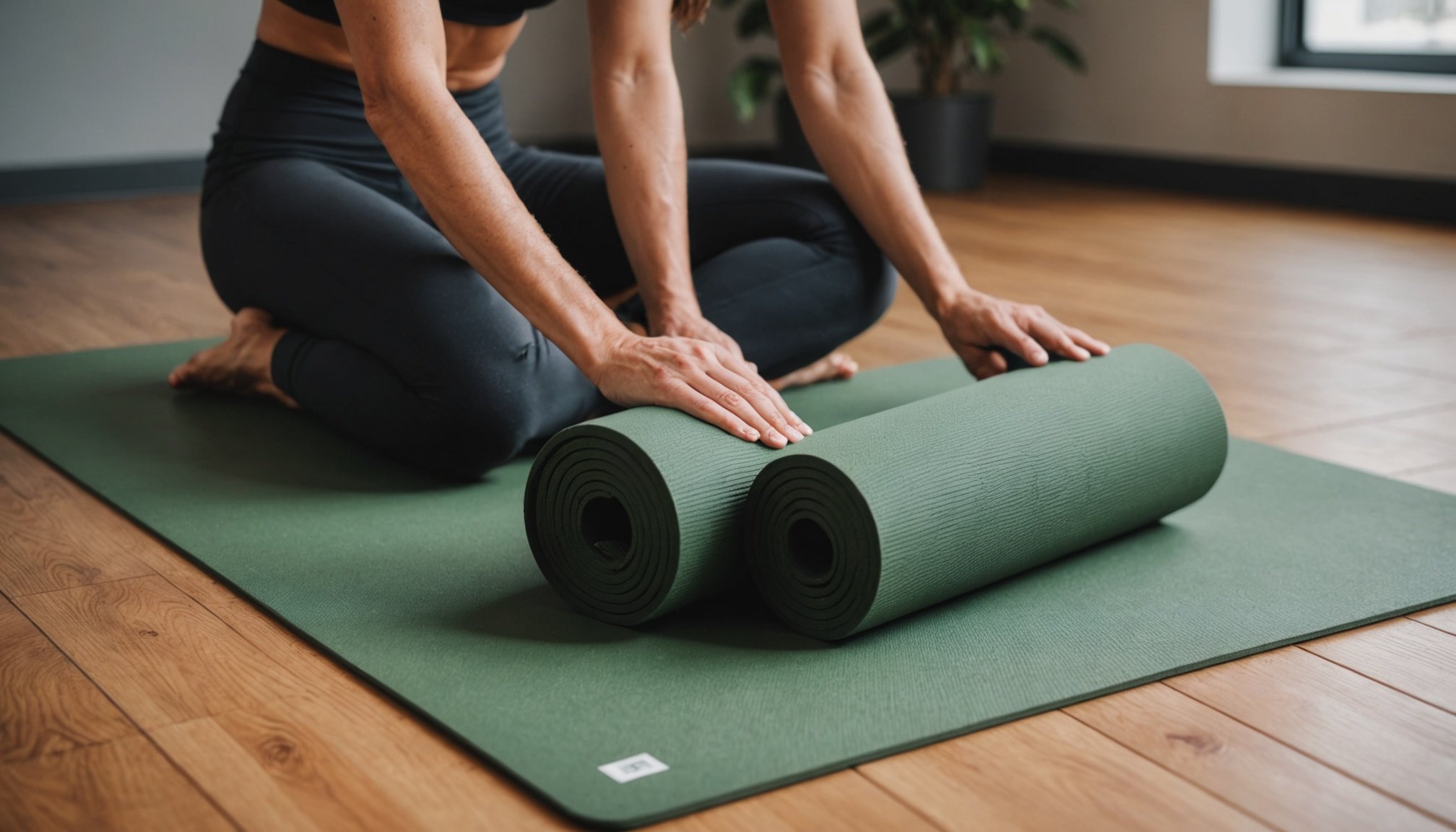Overview of Eco-Conscious Yoga Mats
In the quest for a greener lifestyle, eco-friendly yoga mats have become increasingly popular among yoga enthusiasts. These mats prioritize the use of sustainable materials, offering an environmentally responsible choice for practitioners. The importance of using eco-friendly materials in yoga mats cannot be overstated. Conventional mats often rely on PVC, which is harmful to the environment due to its non-biodegradable nature.
Choosing yoga mats with sustainable materials like natural rubber, organic cotton, and jute can significantly reduce environmental impact. These materials decompose more easily and are often produced through environmentally-friendly practices, ensuring a lower carbon footprint. Additionally, they are typically free from harmful chemicals, promoting a healthier practice space.
Also to see : Top UK Vegan Leather Jacket Brands You Need to Know About!
To maximize the environmental benefits, it’s crucial to look for key features when selecting eco-conscious yoga mats:
- Biodegradability: Mats made from organic substances that naturally break down.
- Non-toxicity: Ensure the absence of harmful chemicals.
- Durability: Sustainable mats are designed to last longer, reducing the need for frequent replacements.
Incorporating eco-friendly yoga mats into practice not only improves personal wellness but also contributes positively to the planet, aligning with a broader mission of sustainability.
Also read : Top Eco-Conscious Footwear Brands in the UK You Need to Know About
Top Eco-Conscious Yoga Mat Brands
Exploring yoga mats that are both high-quality and sustainable can seem daunting. Here’s a look at some of the best yoga mat brands that excel in eco-friendly practices, particularly in the UK market.
Brand Name 1
Sustainability practices for this brand revolve around innovative production methods designed to reduce waste. By utilizing closed-loop recycling processes, they ensure minimal landfill contributions, promoting a zero-waste philosophy.
Regarding materials used in production, they prefer natural rubber or organic cotton, reducing reliance on non-biodegradable materials. Their mats are often biodegradable, appealing to consumers eager to lessen environmental impacts.
When considering pricing and availability, these mats are competitively priced, often found both in specialized stores and online marketplaces. Regular discounts make them accessible to a wide audience, expanding their reach.
Brand Name 2
With a strong emphasis on sustainability practices, this brand invests in reforestation projects to offset its carbon footprint, paving the way for environmentally-conscious manufacturing.
In terms of materials, they use recycled plastics and organic fibres. This not only supports sustainable yoga mats in the UK but also ensures durability and quality.
For pricing and availability, their products are priced at a premium but justify the cost through longevity and environmental benefits. Availability in major retailers makes them convenient for many consumers.
Detailed Comparisons of Yoga Mats
When navigating the world of yoga mats, it’s crucial to consider the materials and sustainability practices used in their creation. A side-by-side analysis reveals variations in mat composition: some use natural rubber or cork, catering to eco-conscious yogis, while others rely on synthetic materials. Mats incorporating sustainable materials not only appeal to environmentally-aware consumers but often offer superior grip and durability.
Understanding user experiences through product reviews is another crucial aspect. Reviews provide insight into the performance of mats in different yoga practices, highlighting which ones excel in restorative versus dynamic Vinyasa sessions. While thicker mats might provide comfort for restorative yoga, those preferring Vinyasa could benefit from a thinner mat for better stability.
Another factor in yoga mat comparisons is pricing. The cost of mats can range widely, often reflecting quality and material sustainability. Premium mats are generally higher priced due to better durability and eco-friendly materials, whereas budget-friendly options might lack these features but are accessible for beginners.
Customer experiences offer recommendations based on individual needs, elevating the mat choice from mere purchasing to an informed decision, enhancing the overall yoga practice experience.
Tips for Choosing an Eco-Friendly Yoga Mat
When choosing yoga mats, it’s crucial to focus on materials that align with sustainable values. Opt for mats made from natural rubber, cork, or jute, as these are biodegradable and reduce environmental impact compared to synthetic alternatives like PVC. These materials contribute to long-term sustainability, aligning with eco-conscious purchasing decisions.
Consider your personal practice style. If your routine includes intense, sweaty sessions, a natural rubber mat with excellent grip might be ideal. For more meditative practices, a softer jute mat could provide just the right amount of comfort. Your preference plays a significant role in making a sustainable buying guide effective.
It’s easy to be swayed by short-term trends that promise extraordinary features. However, keeping a long-term perspective ensures that your choices benefit both your practice and the planet. Investing in quality mats crafted for durability minimizes waste and supports eco-conscious purchasing habits.
In summary, choosing yoga mats with an eye for sustainability goes beyond trends—it involves selecting materials that foster both personal and environmental wellness. By considering your practice style and valuing longevity over novelty, you effectively contribute to a more sustainable future.
Customer Reviews and Experiences
Understanding user reviews and insights from customer feedback provides valuable information about different eco-conscious yoga mat brands. These testimonials present a range of yoga mat experiences that highlight both the challenges and rewards users encounter during their practices.
Many customers appreciate the durability and non-slip qualities of eco-friendly mats, which enhance their yoga routines by providing stable support. Anecdotal experiences shared in feedback reflect an array of unique situations, such as practising yoga in diverse environments—indoors, outdoors, or even on uneven surfaces. These diverse experiences exemplify how various brands cater to different user needs.
Consistent reporting from users who have tested these products over time shows how sustained usage affects mat performance. Customers frequently express satisfaction with mats that maintain grip and structure after prolonged use, reinforcing the notion that quality sustains practice effectiveness. Reviews also illuminate concerns like initial odours or material stiffness, which often dissipate with use.
In summary, feedback from a spectrum of users illustrates both the immediate and long-term benefits of choosing the right eco-conscious yoga mat. Whether for beginners or seasoned yogis, these insights can guide informed decision-making in selecting a mat that aligns with personal practice and preferences.
Visual Guide to Eco-Conscious Yoga Mats
Choosing the right yoga mat can make a significant difference in your practice, so let’s delve into the world of eco-friendly options using a visual guide. Incorporating visuals helps highlight product characteristics such as texture, grip, and durability effectively.
When comparing eco-conscious yoga mats, it’s essential to look at the texture that offers enhanced grip. This feature is crucial for maintaining stability during poses. Visual guides can display the differences in materials like natural rubber, cork, and jute, each offering unique textures and grip levels.
Durability is another critical characteristic; sustainable yoga mats often use high-quality, long-lasting materials, reducing the need for frequent replacements. In our visual comparisons, note how these materials stand up to wear and tear.
Color and design also play a significant role in personal expression and aesthetics. Eco-friendly mats come in various colors and designs, and visual guides can help illustrate the array of choices available. From earthy tones to vibrant patterns, there’s something for every yogi’s style preference.
By using a visual guide, you can better understand these features, assisting you in making an informed decision that aligns with both your practice needs and eco-conscious values.











